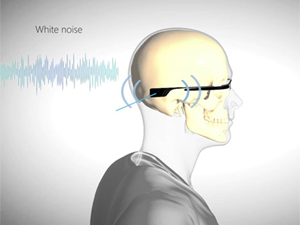



Date:19/08/16
 Conventional passwords are marching to their death, and biometric authentication might be the future, especially with the possibility of widespread fingerprint scanning or facial-recognition technology. And now, researchers in Germany have a new way to give users access to their devices. Their technique, which they call "SkullConduct," relies on the unique way sound passes through each person's skull. Every skull modifies sound differently, and the researchers measured those minute differences to use as an authentication system.
Conventional passwords are marching to their death, and biometric authentication might be the future, especially with the possibility of widespread fingerprint scanning or facial-recognition technology. And now, researchers in Germany have a new way to give users access to their devices. Their technique, which they call "SkullConduct," relies on the unique way sound passes through each person's skull. Every skull modifies sound differently, and the researchers measured those minute differences to use as an authentication system.
The researchers took 10 participants and put them in a silent room. They recorded skull vibration samples by having them each wear a modified Google Glass that played white noise. The Google Glass application records sound as it plays and converts the data it gathers into a byte file. Each participants's skull vibration sample was recorded 10 times, which the researchers then used to test whether the Google Glass could correctly identify them. The system correctly recognized users 97 percent of the time.
The researchers stipulate that their test didn't take into account background noise, like a subway's roar or people chatting nearby. They also say weight gain or hair growth could alter results. Though they're not at 100 percent just yet, it could be cool if our skulls were used for biometric authentication. That is, if people ever legitimately start wearing Google Glass and eyewear computers.
Researchers are using the vibration of your skull to identify you
 Conventional passwords are marching to their death, and biometric authentication might be the future, especially with the possibility of widespread fingerprint scanning or facial-recognition technology. And now, researchers in Germany have a new way to give users access to their devices. Their technique, which they call "SkullConduct," relies on the unique way sound passes through each person's skull. Every skull modifies sound differently, and the researchers measured those minute differences to use as an authentication system.
Conventional passwords are marching to their death, and biometric authentication might be the future, especially with the possibility of widespread fingerprint scanning or facial-recognition technology. And now, researchers in Germany have a new way to give users access to their devices. Their technique, which they call "SkullConduct," relies on the unique way sound passes through each person's skull. Every skull modifies sound differently, and the researchers measured those minute differences to use as an authentication system.The researchers took 10 participants and put them in a silent room. They recorded skull vibration samples by having them each wear a modified Google Glass that played white noise. The Google Glass application records sound as it plays and converts the data it gathers into a byte file. Each participants's skull vibration sample was recorded 10 times, which the researchers then used to test whether the Google Glass could correctly identify them. The system correctly recognized users 97 percent of the time.
The researchers stipulate that their test didn't take into account background noise, like a subway's roar or people chatting nearby. They also say weight gain or hair growth could alter results. Though they're not at 100 percent just yet, it could be cool if our skulls were used for biometric authentication. That is, if people ever legitimately start wearing Google Glass and eyewear computers.
Views: 485
©ictnews.az. All rights reserved.Similar news
- Azerbaijani project to monitor disease via mobile phones
- Innovative educational system to be improved under presidential decree
- NTRC prolongs license of two TV and radio organizations for 6 years
- Azerbaijan establishes e-registry for medicines
- Azerbaijani museum introduces e-guide
- Nar Mobile opens “Nar Dunyasi” sales and service center in Siyazan city
- International conference on custom electronic services held in Baku
- OIC secretary general to attend COMSTECH meeting in Baku
- Azerbaijan develops earthquake warning system
- New law to regulate transition to digital broadcasting in Azerbaijan
- Azerbaijani State Social Protection Fund introduces electronic digital signature
- Intellectual traffic management system in Baku to be commissioned in December
- Tax Ministry of Azerbaijan started receiving video-addresses
- World Bank recommends Azerbaijan to speed up e-service introduction in real estate
- Azerbaijan to shift to electronic registration of real estate





















